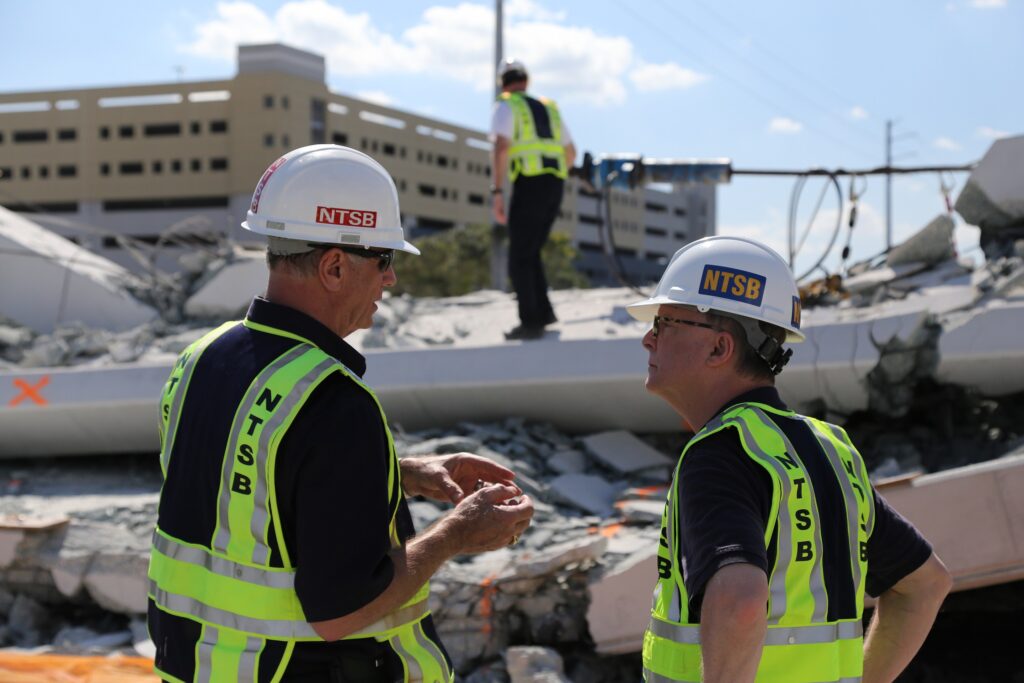08 Jul Learning from engineering failures

A member of the NTSB’s Go Team that is investigating Thursday’s collapse of a bridge on the FIU campus, examines debris while Investigator in Charge Robert Accetta briefs NTSB Chairman Robert Sumwalt on the status of the investigation. (NTSB Photo by Chris O’Neil)
It is a sad fact that engineering knowledge has historically often improved following reviews of major disasters and engineering failures, writes BPEQ’s Engineers Australia representative, Evelyn Storey.
On 15 March 2018 a partially constructed pedestrian footbridge at Florida International University in Miami collapsed onto an 8-lane highway below, killing six construction workers and motorists and seriously injuring another ten people. An extensive investigation by the United States National Transportation Safety Board (NTSB) identified numerous failings, including fundamental structural engineering design errors, misunderstandings and poor communication between multiple organisations involved in the project, poor checking processes and review practices, and a lack of qualified engineers supervising both the design and construction stages. There is much to be learned from the Miami footbridge investigation report issued by the NTSB and I recommend that all RPEQs read it if they get the opportunity.
It is a sad fact that engineering knowledge has historically often improved following reviews of major disasters and engineering failures. Professional engineers can often improve their understanding and skills by learning from previous mistakes. As well as any direct technical reasons for each failure, there are often nontechnical issues that contributed to the ultimate outcome, including human errors, ethical shortcomings, and regulatory omissions. By reflecting on such events, we may come to recognise common warning signs in our own future projects that may be pre-cursors to more catastrophic potential outcomes.
‘It is a sad fact that engineering knowledge has historically often improved following reviews of major disasters and engineering failures.’
Whatever your engineering discipline, there are many technical, organisational and behavioural issues which crossover between all industries. The hallmark of a high-performing team is the ability to reflect on past performance, look for opportunities to improve and implement incremental changes. It is critical for the engineering community as a whole to collaborate, learn from past mistakes and create a culture of professional improvement.
In general, high profile engineering failures usually draw media attention and are followed up with detailed investigations with the findings shared widely. They can often result in changes to engineering practice, design standards or legislation. But what about near misses or low-key engineering failures? How do we disseminate and learn from these events which are undoubtedly occurring just as regularly?
Engineering is a decision-making process and errors can occur for many different reasons – fundamental technical errors, lack of expertise, mistakes, incorrect assumptions or incomplete information, and/or miscommunication of design intent. Review, checking and verification processes are designed to identify and eliminate the errors. But based on the complaints received by BPEQ, we know that engineering failures are occurring. Examples include incorrect interpretation of geotechnical investigation data, incorrect determination of wind or seismic loads, wrong load paths or inappropriate design methodologies.
There are often legal or privacy reasons which prevent BPEQ from sharing details of specific incidents. However, it would clearly be very beneficial to the engineering profession if we were to reflect on how and why such errors are occurring. In last month’s BPEQ e-news, we published details of the recently launched Collaborative Reporting for Safer Structures Australasia (CROSS-AUS). The CROSS-AUS website enables confidential reporting of structural incidents and includes a searchable library of past reports and structural safety information to help individuals and organisations learn more about the safety implications of their work. I believe that all RPEQs, whatever their engineering discipline, would benefit from investing some continuing professional development hours in reading and reviewing some of the reports on the site.
More broadly, we all need to consider how we contribute to improving the knowledge of the profession. The projects we work on are an important source of expert know-how and organisational knowledge, but lessons-learned from them are often not systematically incorporated into subsequent projects. As a start, sharing lessons learned within our own organisations prevents other team members from repeating the same mistakes and allows us to take advantage of organisational best practices. Learning should be planned and deliberate and engineers should be prepared to take advantage of the key learning opportunities that projects provide.
EVELYN STOREY
Deputy chair and Engineers Australia representative
BSc (Civil Engineering), DipEm, CPEng, NPER, RPEQ
Ms Storey has served as the Board’s deputy chair since July 2016. She is a highly experienced structural engineer, technical director and business unit manager, with 30 years’ experience in Australia and overseas. She is currently regional director of Aurecon’s South East Queensland operations.

 MY ACCOUNT
MY ACCOUNT
